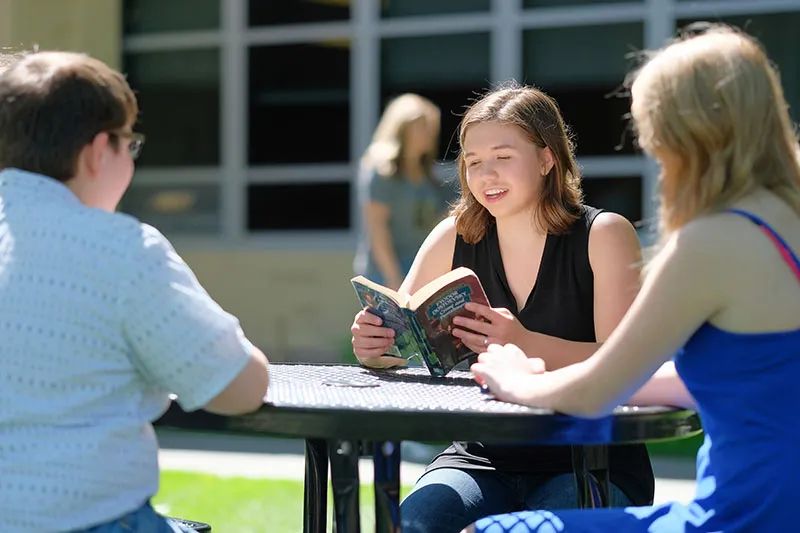
One size does not fit all
More options to that high school diploma than ever before
Taylor Kroft dropped out of high school to go to college. Madi Nance was homeschooled while she worked full time. Keegan Lundman attended public school and took advanced-placement courses so she could study abroad.
All three girls graduated or will graduate with high honors, but their educational paths couldn’t have been more different. They, like other students in Billings, are no longer confined to a rigid curriculum in order to walk across the stage at graduation. They have a dizzying array of choices to get a quality tailor-made education.
NO TO HIGH SCHOOL, YES TO COLLEGE
When 18-year-old Taylor Kroft walked into her high school as a freshman, she had no idea that she’d spend only one year there. She left after her freshman year and opted instead for college, thanks to the University Connections program at Montana State University Billings. She’ll don her cap and gown in December of this year to earn her high school diploma and is already well on her way to earning a degree in elementary education.
“My first two semesters I felt like I stuck out,” Taylor says. “At first, everybody knew I was in high school and I didn’t know how to answer their questions about me being in high school and college at the same time.”
After getting through the growing pains, she has enjoyed the flexibility of the program.
“I liked that I got to pick what classes I was going to take and when,” she says. “You can’t do that in regular high school and I liked that it was a challenge for me.”
After taking a college preparedness aptitude test, students who qualify for the Connections program pay a drastically reduced $50 per credit, compared with the more than $300 per credit that college students pay.
“The financial advantage was a huge thing for me,” Taylor says. “It’s like a huge scholarship.”
Socially, the change from the high school environment to college came with its own set of trials.
“I think I may have been a little young and immature when I started,” Taylor admits. “I stayed up academically, but the workload was different. It can be hard to do these classes by yourself. You don’t have a group of people to hang out with that can help you. It can be isolating.”
That’s exactly why Dr. Becky Lyons, director of Advising and Career Services at MSU Billings, believes that students should dip their toes in the water before jumping into the Connections program with both feet.
“This program shouldn’t replace high school,” Lyons says. “It is designed to go together with high school to help the student become the best college student they can be.”
Taylor and her parents chose high involvement with the homeschool athletic opportunities and a strong church youth group. Taylor, at 5 feet 2 inches, says volleyball might not have been a possibility otherwise.
“I don’t know if I would have been able to play if I was in a regular high school because I’m so short,” she says. She did play all through high school and is now coaching younger players. However challenging the journey, Taylor will graduate from high school with 85 college credits of the 120 required for her bachelor’s degree in elementary education.
“Being in the University Connections program takes time and dedication,” Lyons cautions. “Students need to be aware that the college transcript is a permanent record. However, this program is an excellent way to give students a chance to see if the college environment is right for them. We have staff dedicated to helping these University Connections students.”

EDUCATION CLOSE TO HOME
Taylor’s good friend and hiking buddy, Madison Nance, took another route to her high school diploma. Madi graduated this spring from a homeschool co-op called SAGE, “Seeking a Godly Education.”
SAGE, one of several co-ops in town, is parent-led. Parents decide on classes and often teach them. This year’s high school class had nine students and met one day a week at the Heights’ campus of Harvest Church. Classes that weren’t offered through SAGE were accessible through a variety of homeschool curriculum programs available online.
What Madi loved most was the flexibility.
“I had lots of time for social things,” she says. “I played sports with the homeschool group. I did extra things with friends from 4H and have friends from work and Girl Scouts.”
She was also able to work in an orphanage in Tanzania, Africa, this school year with a group led by her homeschool science teacher. Busy and industrious, Madi also worked full time during her senior year as a barista at City Brew. After graduation, she has her sights set on maybe owning her own business one day. She’d love to travel back to Africa to lend a hand and, in the short term, has visions of car camping with friends.

HIGH SCHOOL CONNECTIONS
Keegan Lundman, who graduated this spring from West High, has big dreams of living abroad one day and wants to pursue a career in academic writing.
“I would love to do research writing,” she says. “I’m interested in sociology and history. I want to write things that put historical context to current issues.” She also wants to learn Russian and has aspirations of living somewhere in Eastern Europe or northern Asia. Her pursuit of Russian language education will take her to the University of Montana in the fall.
“I didn’t expect to go in-state for college, but I found the Russian program there was really great,” Keegan says.
She’s paved the way for her future thanks to a healthy supply of advanced-placement and dual-enrollment classes at West High.
“AP classes are great for our students,” says High School Counselor Beth Toci. “AP is a national program and those classes look very good on a high school transcript. They also do a good job at preparing a student for the rigors of college.”
A major advantage to students taking AP classes is that they receive a weighted grade, meaning they earn an extra .5 on their grade point average, which boosts their overall GPA. The only catch is that students must pay to take an AP test in order for the classes to count toward college credits.
Dual-enrollment classes also gave Keegan a leg up.
“High School Connections is taught in the high schools by high school instructors who have met the Board of Regents qualifications for teaching college-level classes,” says Harold Olson, director of the dual-enrollment program for School District 2. When students take these classes, the credits are guaranteed to be accepted at the Montana universities and usually are accepted out of state as well.
It’s also a big financial advantage, since students pay nothing to take these courses. Olson says the program started three years ago with 52 students. This year, Keegan was one of more than 500 students taking advantage of the program.

LEADING THROUGH INNOVATION
On top of the mix of classes and paths students can take, Billings students have a few extra aces up their sleeves. For high schoolers who have a specific interest area or are looking for one, School District 2 is poised to help with innovative programming through the Billings Career Center.
Shared by the public schools, the Career Center hosts many educational pathways that lead to certifications and work-ready careers through hands-on training and skill-building courses. Students can tap into agricultural classes, instruction on welding, education for healthcare jobs and information technology, to name just a few.
“There is a strong push from the workforce, saying they need people in these areas,” Olson says. “We are able to set kids up to move into the workforce or get them well on their way to being college ready or have a skill they can utilize right away. Some of these kids are starting in high-wage, high-demand jobs.”
Beth Toci agrees, saying, “These pathways are not a lesser choice for students who already know they have a skill or interest in an area. It is a more fitting choice for them.”
A generation ago, students had a set high school curriculum and little in the way of flexibility as they worked to earn a diploma. Today, they have a smorgasbord of options from homeschooling to dual-credit courses and college courses that give them an edge and a financial advantage. The biggest challenge for students and parents? Finding the right fit in a high school education that’s no longer one size fits all.
TO READ MORE ABOUT the High School and University Connections Program and how your student can earn dual credits between high school and college, visit www.msubillings.edu/connections
FOR DETAILS AND CONNECTIONS on homeschooling, visit the Montana Coalition of Home Educations for links to groups in your community.












